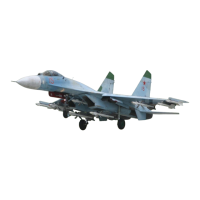Air-To Surface Weapons
Air-to-Surface weapons can be divided into two categories: guided and unguided. Guided air-to-
surface weapons include both powered air-to-surface missiles (AGMs and ASMs) and guided bombs
(GBUs). Unguided weapons include free-fall ("dumb" or "iron") bombs and unguided aerial rockets.
Originally Su-27 can use only unguided bombs and rockets.
Free-fall bombs are basic weapons of strike aviation that have been widely used in all the large-scale
armed conflicts of the last 80 years. Due to their low cost and availability, they can often be cost-
effective even when compared to more accurate (and expensive) modern guided munitions.
Free-fall bombs are not highly accurate. They follow a ballistic trajectory after release without any
ability to maneuver. To improve aiming accuracy, the bombing aircraft should be flying a straight-line
trajectory at the moment of release. Even small amounts of pitch and bank error can degrade the
aiming accuracy, as can the wind. Free-fall bombs can't be used against pinpoint targets (i.e. when
high aiming accuracy is required) or "surgical strikes" in which "collateral damage" around the vicinity
of the target cannot be tolerated.
EVEN INCORRECT AIRCRAFT YAW AT THE MOMENT OF RELEASE CAN DEGRADE THE HIT ACCURACY OF FREE-FALL
BOMBS.
The horizontal distance that a free-falling bomb will travel before hitting the ground depends
primarily on two factors: aircraft speed and altitude at the moment of release. If the aircraft speed
and altitude are increased, the bomb trajectory will be extended, but this also degrades hit accuracy.
The size and destructive power of a conventional free-fall bomb is expressed in terms of its weight,
and is usually somewhere between 50 to 1500 kg. Unlike general-purpose bombs, which have a
single warhead, cluster bombs contain a large number of explosive sub-munitions that spread their
destructive power out over a larger area after release.
THE RANGE OF FREE-FALL BOMBS DEPENDS ON THE AIRCRAFT SPEED AND ALTITUDE AT THE MOMENT OF
RELEASE.
Unguided folding-fin aerial rockets are widely employed against lightly armored enemy vehicles and
personnel. A rocket's hit accuracy depends heavily on the conditions at the moment of launch. A
small aircraft aiming error at the moment of launch can lead to a significant rocket deviation from the
target. Wind can also degrade the hit accuracy. Rockets are usually used in volleys, en masse. Using
a large number of rockets can spread destructive power over a significant area, and help ensure
hitting the intended target.
UNGUIDED ROCKETS ARE LAUNCHED IN SALVOS TO ENSURE HITTING THE TARGET.
Free-fall Bombs
Su-27 has some limited ground attack capability, being able to carry free-fall bombs and unguided
rockets in place of air-to-air missiles.
Free-fall bombs lack any guidance or control system. They follow a ballistic trajectory that is affected
by the releasing aircraft's speed and dive angle.

